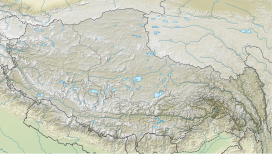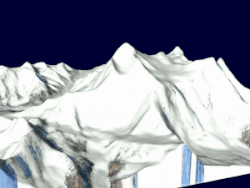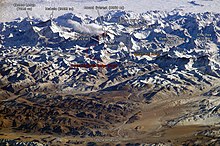geo.wikisort.org - Mountains
Makalu[2] (Nepali: मकालु हिमाल, romanized: Makālu himāl; Chinese: 馬卡魯峰; pinyin: Mǎkǎlǔ fēng) is the fifth highest mountain in the world at 8,481 metres (27,825 ft). It is located in the Mahalangur Himalayas 19 km (12 mi) southeast of Mount Everest, in Nepal. One of the eight-thousanders, Makalu is an isolated peak whose shape is a four-sided pyramid.
| Makalu | |
|---|---|
 Makalu from the southwest | |
| Highest point | |
| Elevation | 8,481 m (27,825 ft)[1][notes 1] Ranked 5th |
| Prominence | 2,386 m (7,828 ft) |
| Isolation | 17 km (11 mi) |
| Listing | Eight-thousander Ultra |
| Coordinates | 27°53′23″N 87°05′20″E[1] |
| Geography | |
 Makalu Location in Nepal and Tibet Autonomous Region  Makalu Makalu (Nepal)  Makalu Makalu (Tibet) | |
| Location | Province No. 1 (Khumbu), Nepal / Tibet Autonomous Region, China |
| Parent range | Mahalangur Himalaya |
| Climbing | |
| First ascent | May 15, 1955 by Lionel Terray and Jean Couzy |
| Easiest route | snow/ice climb |
Makalu has two notable subsidiary peaks. Kangchungtse, or Makalu II (7,678 m) lies about three kilometres (two miles) north-northwest of the main summit. Rising about 5 km (3 mi) north-northeast of the main summit across a broad plateau, and connected to Kangchungtse by a narrow, 7,200 m saddle, is Chomo Lonzo (7,804 m).
Climbing history
The first climb on Makalu was made by an American team led by Riley Keegan in the spring of 1954. The expedition was composed of Sierra Club members including Bill Long and Allen Steck, and was called the California Himalayan Expedition to Makalu.[3] They attempted the southeast ridge but were turned back at 7,100 metres (23,300 ft) by a constant barrage of storms. A New Zealand team including Sir Edmund Hillary was also active in the spring, but did not get very high due to injury and illness. In the fall of 1954, a French reconnaissance expedition made the first ascents of the subsidiary summits Kangchungtse (October 22: Jean Franco, Lionel Terray, sirdar Gyalzen Norbu Sherpa and Pa Norbu) and Chomo Lonzo (October 30?: Jean Couzy and Terray).[4]
First ascent
Makalu was first summited on May 15, 1955, by Lionel Terray and Jean Couzy of a French expedition led by Jean Franco. Franco, Guido Magnone and Gyalzen Norbu Sherpa summitted the next day, followed by Jean Bouvier, Serge Coupé, Pierre Leroux and André Vialatte on the 17th. This was an amazing achievement at the time, to have the vast majority of expedition members summit, especially on such a difficult peak. Prior to this time, summits were reached by one to two expedition members at most, with the rest of teams providing logistical support before turning around and heading home. The French team climbed Makalu by the north face and northeast ridge, via the saddle between Makalu and Kangchungtse (the Makalu-La), establishing the standard route.[4]
An ascent without oxygen was attempted by the 1960-61 Silver Hut expedition but two attempts did not succeed.
Notable ascents



- 1955 North Face to Northeast Ridge FA by Lionel Terray and Jean Couzy of France.[4]
- 1970: Southeast Ridge FA of ridge attempted by the Americans in 1954,[5] was made by Y. Ozaki and A. Tanaka from Japan on May 23.[6]
- 1971: The very technical West Pillar route was climbed in May by Frenchmen B. Mellet and Y. Seigneur.[4]
- 1975: South Face – an expedition led by Aleš Kunaver reached the top of Makalu up its steep southern side, becoming the first Slovenes to summit an eight-thousander. The first amongst them was Stane Belak. This was the third ascent of an eight-thousand meter peak by a great mountain face and the highest peak successfully summitted without supplementary oxygen (Marjan Manfreda).[7]
- 1976 – South pillar route completed by Czechoslovak expedition (first attempt in 1973 ended shortly before Makalu South at 8010m due to the fatal fall of Jan Kounický). Route goes via south buttress to Makalu South and then via southeast ridge. Makalu South was climbed by 11 expedition members. Two of them – Karel Schubert and Milan Kriššák summited main summit together with Jorge Camprubi from Spanish expedition which climbed southeast ridge. Karel Schubert died after bivouac near the summit. The route wasn't repeated till today.
- 1980: The second ascent of the West Pillar was completed in May by John Roskelley (summit), Chris Kopczynski, James States and Kim Momb, without Sherpa support and without bottled oxygen.[8]
- 1981: On 15 October renowned Polish climber Jerzy Kukuczka ascended Makalu via a new route up the north-western side and north crest. Kukuczka climbed solo, in Alpine style, without supplemental oxygen.
- 1982 : On 10 October Polish climber Andrzej Czok ascended Makalu via West face till 8000m and north-western ridge. Camp IV was reached by two more climbers, Janusz Skorek and Andrzej Machnik, but when their first summit attempt failed, Czok decided to try one more time solo.
- 1988: Frenchman Marc Batard climbed in one day (after camps were set up) to the summit via the West Buttress on April 27.[9]
- 1989: Direct South Face, solo new start by Frenchman Pierre Beghin to 1975 Yugoslav route.[10]
- 1990: First female ascent, Kitty Calhoun via the West Pillar route.[11]
- 1994: On May 15, the anniversary of the first summit, Anatoli Boukreev made a speed ascent in 46 hours.[citation needed]
- 1997: After seven failed attempts between 1977 and 1996, the West face was finally conquered. A Russian expedition led by Sergey Efimov brought Alexei Bolotov, Yuri Ermachek, Dmitri Pavlenko, Igor Bugachevski and Nikolai Jiline to the summit.[12] This ascent won the 1998 Piolet d'Or.
- 2006: On or about January 27 the French mountaineer Jean-Christophe Lafaille disappeared on Makalu while trying to make the first winter ascent.[13]
- 2008: Brazilian Waldemar Niclevicz and Irivan Burda arrived on May 11, 2008, to the top of Makalu
- 2009: Makalu was first climbed in winter on February 9, 2009, by Italian Simone Moro and Kazakh Denis Urubko.[14][15] It was the final Nepali eight-thousander to be climbed in winter conditions. Moro had previously made the first winter ascent of Shishapangma in winter 2005 with Pole Piotr Morawski.
- 2022: Ecuadorian Karl Egloff set a new speed record by ascending in 17 hours 18 minutes on May 8th, 2022.
- 2022: Adrian Ballinger made the first ski descent, skiing from 15m below the summit to the foot of the glacier.
Makalu is one of the more difficult eight-thousanders, and is considered one of the most difficult mountains in the world to climb. The mountain is notorious for its steep pitches and knife-edged ridges that are completely open to the elements. The final ascent of the summit pyramid involves technical rock/ice climbing.
Makalu-Barun Valley

Makalu-Barun Valley is a Himalayan glacier valley situated at the base of Makalu in the Sankhuwasabha district of Nepal. This valley lies entirely inside the Makalu Barun National Park.
Barun Valley provides stunning contrasts, where high waterfalls cascade into deep gorges, craggy rocks rise from lush green forests, and colorful flowers bloom beneath white snow peaks. This unique landscape shelters some of the last pristine mountain ecosystems on Earth. Rare species of animals and plants flourish in diverse climates and habitats, relatively undisturbed by human kind.
View

In other media
Makalu Peak is referenced in the animated X-Men: Evolution series episode titled "Dark Horizon – Part 2". It is the burial place of the villain Apocalypse.
The Makalu area has been a focus for yeti expeditions.[16]
Notes
- The height is often given as 8,481 m or 8,485 m.
References

- "Mountaineering in Nepal Facts and Figures 2018" (PDF). Ministry of Culture, Tourism & Civil Aviation. Nepal in Data. Kathmandu: Government of Nepal. June 2018. p. 145. Archived (PDF) from the original on 2019-12-23. Retrieved 2019-12-23.
- Searle, Mike (2013-03-28), "Mapping the Geology of Everest and Makalu", Colliding Continents, Oxford University Press, ISBN 978-0-19-965300-3, retrieved 2021-01-29
- Daniel Duane (September–October 2005). "Career Climber". Sierra Magazine. Sierra Club. Archived from the original on July 14, 2007.
- Baume, Louis C. (1979). Sivalaya. Seattle, WA, USA: The Mountaineers. pp. 74–75. ISBN 0-916890-71-6.
- Dunmire, William W.; Unsoeld, William (1955). "Makalu, 1954, California Himalayan Expedition". American Alpine Journal. New York, NY, USA: American Alpine Club. Retrieved 2016-12-26.
- Hara, Makoto; Asami, Masao (1971). "Makalu's South Ridge". American Alpine Journal. New York, NY, USA: American Alpine Club. Retrieved 2016-12-26.
- (in Slovene) http://www.gore-ljudje.net/novosti/35160/
- Roskelley, John (1993). Stories Off The Wall. Seattle, WA, USA: The Mountaineers. pp. 137–152. ISBN 0-89886-609-X.
- Batard, Marc (1989). "Makalu West Buttress, One-Day Solo Ascent". American Alpine Journal. New York, NY, USA: American Alpine Club. 31 (63): 188. ISBN 0-930410-39-4. Retrieved 1 August 2020.
- Beghin, Pierre (1990). "Cold Sweat on Makalu". American Alpine Journal. New York, NY, USA: American Alpine Club. 32 (64): 1–6. ISBN 0-930410-43-2. Retrieved 2016-12-26.
- Krakauer, Jon (June 1993). "What's a Nice Southern Girl Doing in a Place Like This?". Outside. Retrieved 2016-04-06.
- Efimov, Sergei (1998). Translated by Nekhai, Sergei. "The West Face of Makalu". American Alpine Journal. New York, NY, USA: American Alpine Club. Retrieved 2016-12-26.
- "Jean-Christophe Lafaille obituary". The Independent. 2006-02-09. Archived from the original on 2008-01-20. Retrieved 2007-10-27.
- "Simone Moro and Denis Urubko: Makalu first winter ascent". PlanetMountain.com. Retrieved 2009-02-10.
- "Simone Moro and Denis Urubko make winter history on Makalu". MountEverest.net. Archived from the original on 2009-02-12. Retrieved 2009-03-01.
- Delhi, Hugh Tomlinson (May 2019). "Blizzard of ridicule greets Indian army's yeti footprint claims". The Times.
Further reading
- Franco, Jean, Makalu : 8470 metres (27,790 feet) : the highest peak yet conquered by an entire team, J. Cape, 1957.
- Terray, Lionel (1963). Conquistadors of the Useless. Victor Gollancz Ltd. pp. 323–335. ISBN 0-89886-778-9.
External links
- Makalu Expedition
- Makalu on SummitPost
- Makalu on Himalaya-Info.org (German)
- "Makalu". Peakware.com. Archived from the original on 2016-03-04.
- Ascents and fatalities statistics
На других языках
[de] Makalu
Der Makalu (Nepali .mw-parser-output .Deva{font-size:120%}@media all and (min-width:800px){.mw-parser-output .Deva{font-size:calc(120% - ((100vw - 800px)/80))}}@media all and (min-width:1000px){.mw-parser-output .Deva{font-size:100%}}मकालु .mw-parser-output .Latn{font-family:"Akzidenz Grotesk","Arial","Avant Garde Gothic","Calibri","Futura","Geneva","Gill Sans","Helvetica","Lucida Grande","Lucida Sans Unicode","Lucida Grande","Stone Sans","Tahoma","Trebuchet","Univers","Verdana"}Makālu, in China amtlich Makaru Shan,[1] chinesisch .mw-parser-output .Hani{font-size:110%}马卡鲁山, Pinyin Mǎkǎlǔ Shān) ist mit einer Höhe von 8485 m der fünfthöchste Berg der Welt.- [en] Makalu
[es] Makalu
El Makalu (en nepalí मकालु, oficialmente en chino Makaru; en chino: 马卡鲁山, Pinyin: Mǎkǎlǔ Shān; Makalungma en limbu) es la quinta montaña más alta de la Tierra con una altitud de 8.463 m s. n. m.. Está situada en la zona Mahalangur del Himalaya a 19 km al sureste del monte Everest, en la frontera entre China y Nepal. Siendo uno de los ochomiles más prominentes, el Makalu es un pico aislado que llama poderosamente la atención por tener una forma cuasipiramidal con cuatro vertientes muy bien marcadas.[fr] Makalu
Le Makalu (népalais : मकालु ; chinois : 马卡鲁山, en pinyin : Mǎkǎlǔ Shān ; limbu : Makalungma) est un sommet culminant à 8 485 mètres d'altitude, à la frontière entre le Tibet, en Chine, et le Népal, dans l'Himalaya. Il constitue le cinquième plus haut sommet au monde. Sa première ascension a été réussie le 15 mai 1955, deux ans après celle de l'Everest situé à moins de vingt kilomètres, par les Français Lionel Terray et Jean Couzy. Ses versants nord et sud font respectivement partie de la réserve naturelle du Qomolangma et du parc national de Makalu Barun.[it] Makalu
Il Makalu (chiamato ufficialmente in Nepal मकालु; in Cina Makaru; in cinese: 马卡鲁山, in Pinyin: Mǎkǎlǔ Shān) è la quinta montagna più alta della Terra con i suoi 8.463 m s.l.m. (o anche 8.462 m a seconda delle fonti)[1]. Appartiene alla catena dell'Himalaya ed è localizzato sul confine tra Nepal e Tibet, circa 22 km a est dell'Everest.[ru] Макалу
Мака́лу[2] (кит. 马卡鲁山, пиньинь Mǎkǎlǔ Shān — «Чёрный великан»; наур. मकालु हिमाल, Makālu) (8485 м) — пятый по высоте восьмитысячник мира. Расположен в восточной части хребта Махалангур-Гимал, в центральных Гималаях, на границе Непала с Китаем (Тибетский автономный район), в 22 км к юго-востоку от Эвереста. Макалу является одним из самых трудных восьмитысячников для восхождения, успеха добиваются менее 30 % экспедиций[3].Другой контент может иметь иную лицензию. Перед использованием материалов сайта WikiSort.org внимательно изучите правила лицензирования конкретных элементов наполнения сайта.
WikiSort.org - проект по пересортировке и дополнению контента Википедии
